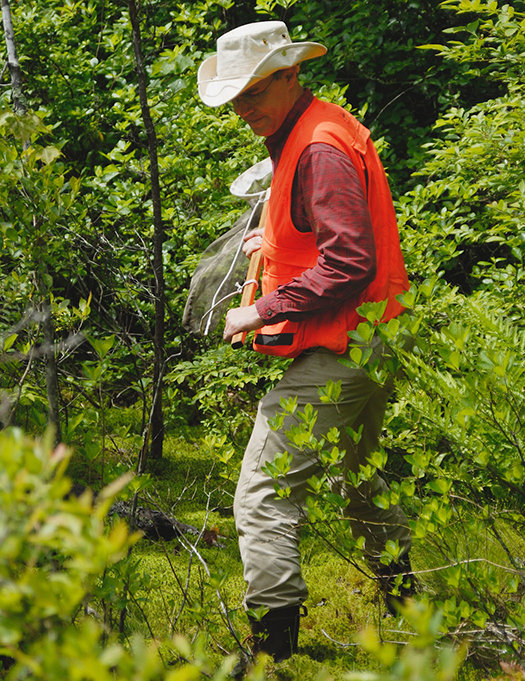Salt-marsh pink
From ecoRI News (ecori.org)
Only two populations of salt-marsh pink are left in Rhode Island, and they are at risk from sea-level rise.
David Gregg worries that not enough is being done to protect Rhode Island’s rare plants.
“There are a lot of plant species that we’re monitoring out of existence,” said Gregg, the executive director of the Rhode Island Natural History Survey. “We check them every year, and there are often fewer of them each year. The best-case scenario is that they stay the same, but many populations are getting smaller and smaller.”
He believes that conservationists must be bolder during the climate crisis if native wild plants are going to survive in the coming decades. Rather than simply monitoring the status of rare plants in Rhode Island, he is advocating for the use of more active strategies to boost plant populations.
“There’s been a big debate among biologists about how active we should be in trying to save rare species,” Gregg said. “Are we going to end up gardening nature? Aren’t we bound to make faulty decisions? If we get involved in active management of rare species, aren’t we doomed to screw it up?”
With little left to lose in some cases, the Natural History Survey has chosen to partner with the Rhode Island Department of Environmental Management and the Native Plant Trust — formerly the New England Wild Flower Society — on an effort to propagate select species of rare plants and transplant them into the wild to augment existing wild populations and establish new populations.
The “Rhode Island At-risk Plant Propagation Project” is an outgrowth of the Rhody Native program, which was established a decade ago to help commercial plant growers propagate native plants for retail sale. At its peak, the program was growing 50 different species, but eventually just one species became dominant, a salt marsh grass used in restoration projects.
“Rhody Native became a commodity growing project, and that’s not our business,” Gregg said. “Our strength is in rare species — learning to propagate them and experimenting with them.”
The Natural History Survey’s “Propagation Project” began last year with the selection of four plants to propagate to test the concept: salt-marsh pink; wild indigo; wild lupine; and several varieties of native milkweed. The lupine and indigo were selected in part because they are the food plant for a rare butterfly, the frosted elfin. Just two populations of salt-marsh pink are left in Rhode Island, and they are at risk from sea-level rise.
“Our populations of marsh pink have very few plants, and we’re worried about inbreeding,” Gregg said. “The idea is to take plants from a Connecticut restoration site, cross pollinate them with plants from Rhode Island to reduce inbreeding, and then return some to Connecticut and use the others to reinforce the Rhode Island populations.”
The big challenge with this kind of project is learning how to propagate the plants in a greenhouse setting.
“These aren’t domesticated plants we’re working with,” said Hope Leeson, a botanist for the Natural History Survey who led the Rhody Native program. “We have to imitate the environmental conditions the plants are adapted to — the temperature, humidity, soil, water, and other factors.”
Salt-marsh pink is a particularly challenging example. It’s an annual species that produces a large quantity of seeds in a good year, but the seeds are extremely small — Leeson described them as “dust-like” — and they don’t tolerate drying, so they can’t be stored over the winter.
“We collected seeds in October and had to sow them immediately,” she said. “In the wild, they grow in a band of vegetation along the top of a salt marsh, where it’s a moist sandy soil mixed with peat. Periodically it floods as the tide comes in and then drains. I’ve got to come up with a soil mixture that’s like the natural conditions to make the plant happy.”
Wild indigo, on the other hand, is very drought tolerant and doesn’t grow well in moist or humid conditions. Its seeds, like those of wild lupine, must be scarified before they will germinate.
“A lot of species in the pea family have a hard seed coat that keeps them from taking in water until conditions are right for germinating,” Leeson said. “In the wild, lupine grows in sandy, gravely soil, so the seeds are likely to get abraded by the sand over the winter, allowing it to take in water to trigger the process of coming out of dormancy.”
To get lupine and indigo seeds to germinate, Leeson must first scratch them with sandpaper to simulate the natural scarification process.
Leeson and volunteers from the Rhode Island Wild Plant Society are raising many of the target plants in greenhouses at the University of Rhode Island’s East Farm and at a private site in Portsmouth.
Gregg said the project is being undertaken on a shoestring budget to demonstrate it’s potential.
“We hope someone will realize that we have this unique capacity to do research propagation of rare plants, and maybe that will help us find some funders to support the project,” he said.
Rhode Island resident and author Todd McLeish runs a wildlife blog.
















